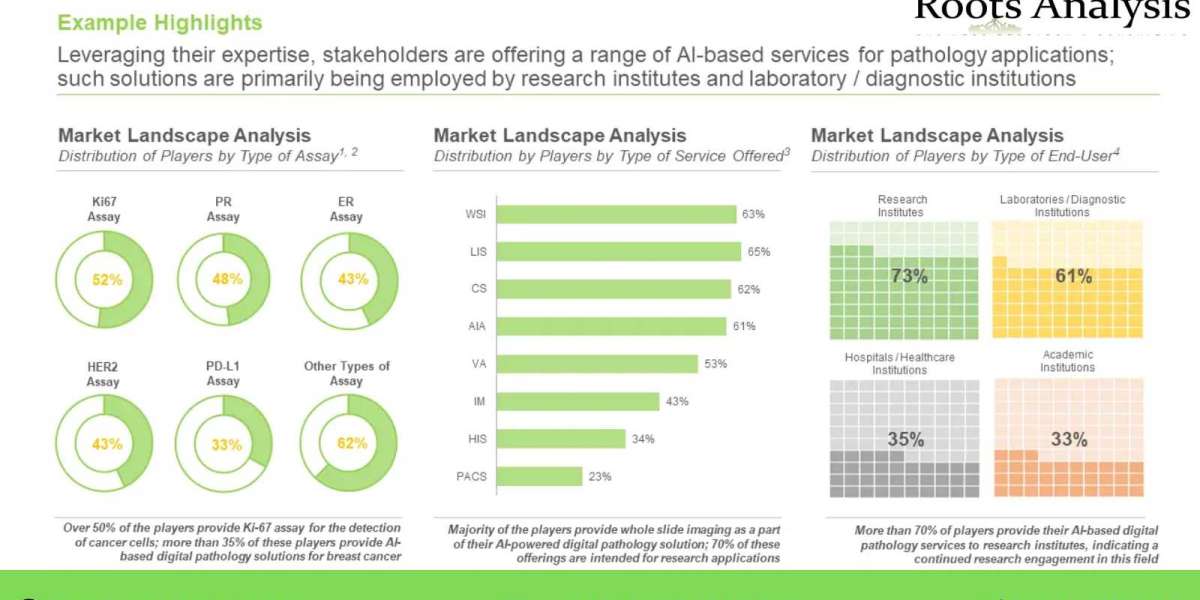With the advent of AI, pathologists are now benefiting from computerized image analysis software that can draw conclusions and deliver diagnoses in a fraction of the time. Now, pathologists can analyze the RNA / DNA or protein expression of a sample, which is far more accurate than visual analysis. AI is being used to analyze images and extract meaningful information from them, to automate tedious tasks, and to create new ways of diagnosing and treating diseases. Pathologists can rely on AI to extract features from images and classify them into appropriate categories for diagnosis.
Benefits of AI in Digital Pathology
AI is revolutionizing digital pathology by improving accuracy, consistency, and operational efficiency. AI is improving accuracy by enabling pathologists to derive more insights from images and improving the consistency of results by reducing bias. AI-driven analysis is repeatable and consistent, leading to more accurate diagnoses. AI is also improving operational efficiency by automating and optimizing workflows. Pathologists can now rely on AI to manage their workflows, reducing the time spent on tedious tasks.
AI-Based Automation of Pathology Workflows
AI is transforming pathology workflows by automating processes and optimizing collaboration among team members. Pathologists can now leverage AI to manage their workflows, helping to optimize workflow operations. AI can be used to automate processes like image acquisition, data management, and report formatting, as well as recordkeeping tasks.
With AI, pathologists can collaborate more effectively with other team members by sending them notifications on issues, such as abnormal test results or abnormal exam findings. AI can be used to facilitate collaboration between pathologists and other health care professionals, such as researchers and clinicians. Pathologists can send images and findings to researchers for further analysis.
AI-based digital pathology process
- Preparation of Tissue Sample
- Converting into Virtual Sample / Whole slide imaging (WSI)
- Saving a Virtual Slide
- Viewing and Editing of Slide
- Sharing Data
- Reporting Results
AI-Driven Automated Diagnosis Treatment
New AI technology is allowing pathologists to make diagnoses and prescribe treatments using a machine-generated narrative. AI is being used to analyze images and extract meaningful information from them, enabling pathologists to make more accurate decisions about diagnoses. AI can be used to analyze tissue samples as well as blood and urine samples to derive a more accurate diagnosis.
New AI technology is allowing pathologists to make diagnoses and prescribe treatments using a machine-generated narrative. AI can be used to analyze images and extract meaningful information from them, enabling pathologists to make more accurate decisions about diagnoses. AI can be used to analyze tissue samples as well as blood and urine samples to derive a more accurate diagnosis.
AI in Enhancing Accessibility Efficiency of Digital Pathology
AI is helping to make digital pathology more accessible, efficient, and reliable. With AI, pathologists can now access more accurate data and insights in a fraction of the time. AI-driven solutions are able to understand and interpret complex data, making them highly accessible and efficient. AI is helping to make digital pathology more reliable by minimizing errors in data analysis. AI is being used to analyze images and extract meaningful information from them, enabling pathologists to make more accurate decisions about diagnoses.
Challenges for AI in Digital Pathology
With the advent of AI, digital pathology is being transformed from visual inspection to molecular analysis. However, there are some challenges associated with AI in digital pathology. The first challenge is the cost of implementation. For organizations to benefit from AI-driven solutions, they have to invest in the technology and hire AI experts to put the technology to use. The second challenge is the lack of understanding of AI by both pathologists and patients. Pathologists are not well-versed with AI and its capabilities, and patients are not aware of the role of AI in pathology, which may lead to inaccurate conclusions.
Conclusion
Digital pathology is transforming the traditional pathology workflow by enabling pathologists to make better, more accurate diagnoses through automated image analysis. With the advent of AI, digital pathology is now able to analyze images and extract meaningful information from them, enabling pathologists to make more accurate decisions about diagnoses. With AI, pathologists can now access more accurate data and insights in a fraction of the time, making it easier for them to make correct decisions about patient care, treatment, and prognosis.
For additional details, please visit
https://www.rootsanalysis.com/blog/how-artificial-intelligence-transforming-digital-pathology/ or email sales@rootsanalysis.com
You may also be interested in the following titles:
- Smart Labels Market: Industry Trends and Global Forecasts, 2022-2035
- 4D Bioprinting Market : Industry Trends and Global Forecasts, 2022-2035
About Roots Analysis
Roots Analysis is a global leader in the pharma / biotech market research. Having worked with over 750 clients worldwide, including Fortune 500 companies, start-ups, academia, venture capitalists and strategic investors for more than a decade, we offer a highly analytical / data-driven perspective to a network of over 450,000 senior industry stakeholders looking for credible market insights.
Contact:
Ben Johnson
+1 (415) 800 3415
Ben.johnson@rootsanalysis.com








